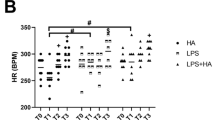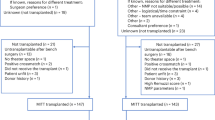Abstract
Background
Application of the immunomodulatory selective cytopheretic device (SCD) to enhance renal replacement therapy and improve outcomes of acute kidney injury in pediatric patients is impeded by safety concerns. Therapy using a pediatric hemodialysis system could overcome these limitations.
Methods
Yucatan minipigs (8–15 kg) with induced septic shock underwent continuous hemodiafiltration with the CARPEDIEM™ pediatric hemodialysis system using regional citrate anticoagulation (RCA) with or without SCD (n = 5 per group). Circuit function plus hemodynamic and hematologic parameters were assessed for 6 h.
Results
SCD was readily integrated into the CARPEDIEM™ system and treatment delivered for 6 h without interference with pump operation. SCD-treated pigs maintained higher blood pressure (p = 0.009) commensurate with lesser degree of lactic acidosis (p = 0.008) compared to pigs only receiving hemodiafiltration. Renal failure occurred in untreated pigs while urine output was sustained with SCD therapy. Neutrophil activation levels and ss-SOFA scores at 6 h trended lower in the SCD-treated cohort.
Conclusions
SCD therapy under RCA was safely administered using the CARPEDIEM™ pediatric hemodialysis system for up to 6 h and no circuit compatibility issues were identified. Sepsis progression and organ dysfunction was diminished with SCD treatment in this model supportive of therapeutic benefit of this immunomodulatory therapy.
Impact
-
SCD therapy with regional citrate anticoagulation has the potential to be administered safely to patients weighing <20 kg using the Carpediem renal replacement therapy platform.
-
Use of a renal replacement therapy platform designed specifically for neonates/infants overcomes safety concerns for delivery of SCD treatment in this population.
-
SCD therapy using the Carpediem renal replacement therapy platform retained the suggestive efficacy seen in larger children and adults to reduce organ injury and dysfunction from sepsis.
Similar content being viewed by others
Log in or create a free account to read this content
Gain free access to this article, as well as selected content from this journal and more on nature.com
or
Data availability
The datasets generated during and/or analyzed during the current study are available from the corresponding author on reasonable request.
References
Kaddourah, A., Basu, R. K., Bagshaw, S. M., Goldstein, S. L. & AWARE Investigators. Epidemiology of acute kidney injury in critically ill children and young adults. N. Engl. J. Med. 376, 11–20 (2017).
Goldstein, S. L. Advances in pediatric renal replacement therapy for acute kidney injury. Semin. Dial. 24, 187–191 (2011).
Symons, J. M. et al. Demographic characteristics of pediatric continuous renal replacement therapy: a report of the prospective pediatric continuous renal replacement therapy registry. Clin. J. Am. Soc. Nephrol. 2, 732–738 (2007).
Basu, R. K. et al. Identification of candidate serum biomarkers for severe septic shock-associated kidney injury via microarray. Crit. Care 15, R273 (2011).
Hotchkiss, R. S. & Karl, I. E. The pathophysiology and treatment of sepsis. N. Engl. J. Med. 348, 138–150 (2003).
Schouten, M., Wiersinga, W. J., Levi, M. & van der Poll, T. Inflammation, endothelium, and coagulation in sepsis. J. Leukoc. Biol. 83, 536–545 (2008).
Humes, H. D., Fissell, W. H. & Weitzel, W. F. The bioartificial kidney in the treatment of acute renal failure. Kidney Int. 61, S121–S125 (2002).
Humes, H. D. Bioartificial kidney for full renal replacement therapy. Semin. Nephrol. 20, 71–82 (2000).
Brown, K. A. et al. Neutrophils in development of multiple organ failure in sepsis. Lancet 368, 157–169 (2006).
Ding, F. et al. A biomimetic membrane device that modulates the excessive inflammatory response to sepsis. PLoS ONE 6, e18584 (2011).
Tumlin, J. A. et al. The effect of the selective cytopheretic device on acute kidney injury outcomes in the intensive care unit: a multicenter pilot study. Semin. Dial. 26, 616–623 (2013).
Tumlin, J. A. et al. A multi-center, randomized, controlled, pivotal study to assess the safety and efficacy of a selective cytopheretic device in patients with acute kidney injury. PLoS ONE 10, e0132482 (2015).
Goldstein, S. L. et al. Use of the selective cytopheretic device in critically ill children. Kidney Int. Rep. 6, 775–784 (2021).
Selewski, D. T. et al. Immunomodulatory device therapy in a pediatric patient with acute kidney injury and multiorgan dysfunction. Kidney Int. Rep. 2, 1259–1264 (2017).
Pino, C. J., Westover, A. J., Johnston, K. A., Buffington, D. A. & Humes, H. D. Regenerative medicine and immunomodulatory therapy: insights from the kidney, heart, brain, and lung. Kidney Int. Rep. 3, 771–783 (2018).
Pino, C. J. et al. Cell-based approaches for the treatment of systemic inflammation. Nephrol. Dial. Transpl. 28, 296–302 (2013).
Pino, C. J., Yevzlin, A. S., Tumlin, J. & Humes, H. D. Cell-based strategies for the treatment of kidney dysfunction: a review. Blood Purif. 34, 117–123 (2012).
Goldstein, S. L. et al. Survival of infants treated with ckrt: comparing adapted adult platforms with the carpediem. Pediatr. Nephrol. 37, 667–675 (2021).
National Research Council. Guide for the Care and Use of Laboratory Animals: Eighth Edition (The National Academies Press, 2011).
Swindle, M. M., Makin, A., Herron, A. J., Clubb, F. J. Jr. & Frazier, K. S. Swine as models in biomedical research and toxicology testing. Vet. Pathol. 49, 344–356 (2012).
Waterhouse, A. et al. Modified clinical monitoring assessment criteria for multi-organ failure during bacteremia and sepsis progression in a pig model. Adv. Crit. Care Med. 1, 002 (2018).
Yessayan, L. et al. Regional citrate anticoagulation “non-shock” protocol with pre-calculated flow settings for patients with at least 6 l/hour liver citrate clearance. BMC Nephrol. 22, 244 (2021).
Dominguez, J. et al. Workshop studies on monoclonal antibodies in the myeloid panel with Cd11 specificity. Vet. Immunol. Immunopathol. 80, 111–119 (2001).
Zarbock, A. et al. Effect of regional citrate anticoagulation vs systemic heparin anticoagulation during continuous kidney replacement therapy on dialysis filter life span and mortality among critically ill patients with acute kidney injury: a randomized clinical trial. JAMA 324, 1629–1639 (2020).
Funding
This work was generously funded through the Frankel Innovation Initiative at the University of Michigan and private donation by Stuart and Maxine Frankel and the National Institutes of Health (NIH) Small Business for Innovative Research (SBIR) program through the National Center for Advancing Translational Sciences (NCATS) award R44TR001324-02A1.
Author information
Authors and Affiliations
Contributions
Study design: K.A.J., C.J.P., S.L.G., H.D.H. Data collection and manuscript preparation: K.A.J., C.J.P., G.C., S.K.K. Approval: K.A.J., S.L.G., H.D.H.
Corresponding author
Ethics declarations
Competing interests
K.A.J., C.J.P., S.K.K., and H.D.H. are employees of Innovative BioTherapies (IBT). H.D.H. is a shareholder, an officer, and a director of IBT. K.A.J., C.J.P., and H.D.H. are shareholders of SeaStar Medical, Inc. C.J.P. and H.D.H. are inventors on patents held by SeaStar Medical. H.D.H. is a scientific advisor, a director, and a consultant to SeaStar Medical. S.L.G. receives consulting fees from SeaStar Medical. G.C. has no competing interests. SeaStar Medical was not involved in the execution of this study.
Ethics approval and consent to participate
No patient consent was required for this pre-clinical research study.
Additional information
Publisher’s note Springer Nature remains neutral with regard to jurisdictional claims in published maps and institutional affiliations.
Rights and permissions
About this article
Cite this article
Johnston, K.A., Pino, C.J., Chan, G. et al. Immunomodulatory therapy using a pediatric dialysis system ameliorates septic shock in miniature pigs. Pediatr Res 93, 89–96 (2023). https://doi.org/10.1038/s41390-022-02061-4
Received:
Revised:
Accepted:
Published:
Issue date:
DOI: https://doi.org/10.1038/s41390-022-02061-4



